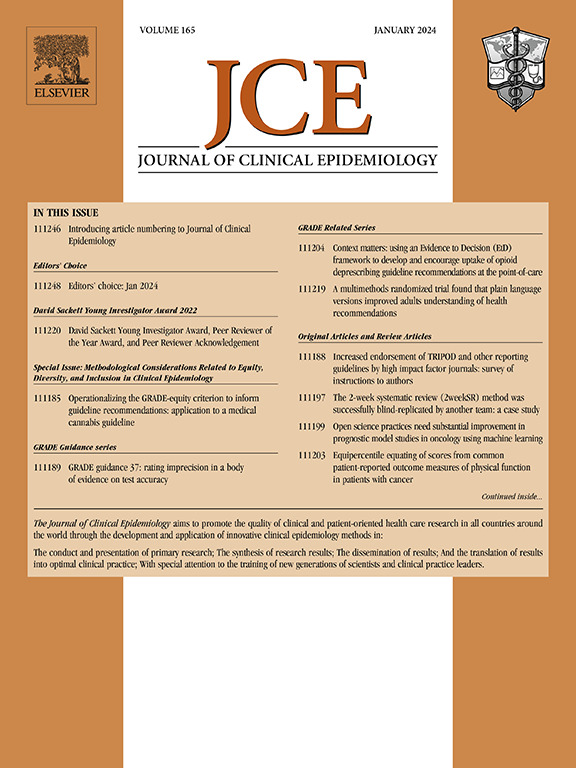Lack of data collection in clinical trials prevents us from evaluating inclusion of people with disabilities
IF 7.3
2区 医学
Q1 HEALTH CARE SCIENCES & SERVICES
引用次数: 0
Abstract
Objectives
Improving clinical trial inclusivity for diverse populations, including people with disabilities, is crucial. Ethical considerations emphasize the need for trial enrollment to mirror the potential trial users' diversity, yet underrepresentation persists due to direct and indirect exclusions. The purpose of our study was to determine if trial teams collect data on people with disabilities for diversity monitoring purposes. We also examined how they collect disability and report it.
Study Design and Setting
We reviewed trial reports for randomized controlled trials published in the UK National Institute of Health Research library from 2016 to 2021. We extracted data on disability, including if, how and when it was collected, who collected it, the measurements used, and the results presented.
Results
We extracted data from 407 trial reports. Disability was not collected as a demographic characteristic in any trial. 27% (109/407) collected some disability data for other purposes, eg, eligibility, a measure of functional outcome or serious adverse events. Disability was most commonly assessed through questionnaires (65%; 71/109), clinical assessment (17%; 19/109), and interviews (8%; 9/109). A variety of measures were used to collect disability information. In 109 trial reports, the most common was a measure of cognitive function, the Mini Mental State Examination, which accounted for 15% overall.
Conclusion
Disability is not just under recorded or underreported, it is ignored, in trials. As disability is not collected as a demographic characteristic, people with disabilities remain underserved in trials. Given 16% of the global population live with a disability, it is a threat to the generalizability of all trials and risks exacerbating health inequalities of people with a disability.
临床试验中缺乏数据收集使我们无法评估是否纳入残疾人。
目标:提高包括残疾人在内的不同人群的临床试验的包容性至关重要。伦理方面的考虑强调试验招募需要反映潜在试验用户的多样性,但由于直接和间接的排除,代表性不足仍然存在。我们研究的目的是确定试验团队是否为多样性监测目的收集残疾人的数据。我们还研究了他们如何收集和报告残疾情况。研究设计和设置:我们回顾了2016年至2021年在英国国立卫生研究院图书馆发表的随机对照试验报告。我们提取了有关残疾的数据,包括是否收集、如何收集、何时收集、谁收集、使用的测量方法以及呈现的结果。结果:我们从407份试验报告中提取数据。在任何试验中,残疾都没有作为人口统计学特征收集。27%(109/407)出于其他目的收集一些残疾数据,例如,资格、功能结局或严重不良事件的衡量。残疾最常通过问卷进行评估(65%;71/109),临床评估(17%;19/109)和访谈(8%;9/109)。使用了各种方法来收集残疾信息。在109份试验报告中,最常见的是对认知功能的测量,即迷你精神状态检查(MMSE),占总体的15%。结论:在试验中,残疾不仅被低估或低估,而且被忽视。由于残疾没有作为人口统计学特征收集,因此在试验中对残疾人的服务仍然不足。鉴于全球16%的人口患有残疾,这对所有试验的普遍性构成威胁,并有可能加剧残疾人的健康不平等。
本文章由计算机程序翻译,如有差异,请以英文原文为准。
求助全文
约1分钟内获得全文
求助全文
来源期刊

Journal of Clinical Epidemiology
医学-公共卫生、环境卫生与职业卫生
CiteScore
12.00
自引率
6.90%
发文量
320
审稿时长
44 days
期刊介绍:
The Journal of Clinical Epidemiology strives to enhance the quality of clinical and patient-oriented healthcare research by advancing and applying innovative methods in conducting, presenting, synthesizing, disseminating, and translating research results into optimal clinical practice. Special emphasis is placed on training new generations of scientists and clinical practice leaders.
 求助内容:
求助内容: 应助结果提醒方式:
应助结果提醒方式:


